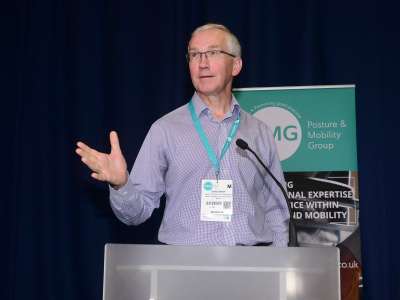
PMG 2019 was the first time that I had attended the group’s conference; I opted to also attend the pre-conference International Society of Wheelchair Professionals (ISWP) Basic Wheelchair Training course, which has improved my knowledge and understanding of manual seating.
As for the main event, I felt the balance and range on offer was excellent.
Of particular interest to me was Dr Chris Daniel’s talk about manufacturing low cost pressure relieving cushions. Chris (pictured) is based at the Rehabilitation Engineering Unit in Bryn y Neuadd Hospital, North Wales, where they manufacture and cover cushions in-house. Chris shared case studies of clients with complex posture and severe pressure risk, where foam cushions with cut-outs are used to completely offload at specific high pressure areas. Chris uses pressure mapping to identify where the hole should be cut. The areas of high pressure in these particular cases were below the ischial tuberosities.
Chris presented two cases where he had trialled this solution and, in both cases, the newly manufactured cushion meant that the client could use their wheelchair for longer. Chris was keen to stress that the solution was not suitable for everyone, and may only apply in certain cases. In addition, a multi-disciplinary approach was used during the assessment and prescription through consultation with a tissue viability nurse.
During the presentation, Chris used basic physics to back up his practice. When a person is sitting on a cushion, a force is applied over the area where there is contact with the cushion surface. Where there is a bony prominence, there is a high force acting downwards over a small area, hence the resulting high pressure. By removing the cushion material underneath the bony prominence, there will be zero pressure on that bony prominence. Further into the presentation, Chris explained that the force applied to the bony prominence had not disappeared, but had been redistributed to the surrounding areas still in contact with the cushion. For one patient, it was calculated that the remaining area in contact with the cushion experienced an additional 11% in load once the hole had been cut away. From further pressure mapping it was found that, despite this additional load, the pressure was well distributed with no large peaks. Some questioned if there would be high pressures experienced on the skin at the edge of the cut hole, but this effect is minimised by chamfering the edge to reduce its harshness on the skin.
With the appropriate application, this low-cost solution is effective for reducing pressure at bony prominences. Having a tissue viability nurse to assess the benefits and risks provides additional confidence when prescribing the solution.
At the time of writing, I am two years into the three-year Scientific Training Programme (STP), based at Morriston Hospital in Swansea, specialising in rehabilitation engineering, and I am particularly interested in specialist seating. I found attending PMG 2019 a fantastic experience, especially being able to network with fellow healthcare professionals to discuss what is current at other services. In addition, learning about new products was very beneficial to further my knowledge of what is available. I would like to thank PMG for very kindly offering me the bursary.
Members of PMG can view Chris's presentation by clicking here.






.jpg)



no comments
Add your comment...